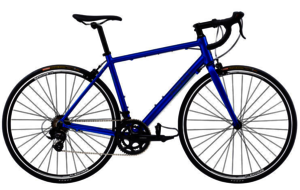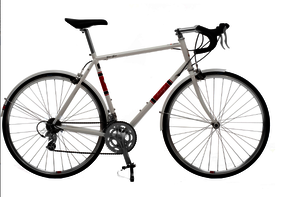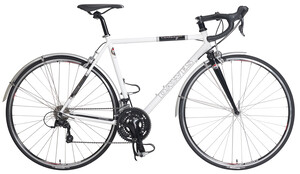Most road bikes aren't meant to take mudguards. That's because they are – ostensibly, at least – designed for racing, and in racing all that counts is where you cross the line. Dirty kit doesn't matter. Getting filthy is a bigger deal for commuting, because even if you ride to work in cycling gear and change you'll have to pull on that cold, soggy kit for the ride home…
Most road bikes aren't meant to take mudguards. That's because they are – ostensibly, at least – designed for racing, and in racing all that counts is where you cross the line. Dirty kit doesn't matter. Getting filthy is a bigger deal for commuting, because even if you ride to work in cycling gear and change you'll have to pull on that cold, soggy kit for the ride home… While it is possible to fit special mudguards, such as SKS Race Blades, a better option for day-to-day commuting is to pick a road bike that will take conventional mudguards.
These road bikes go by various names, such as winter bikes, training bikes, and audax bikes. Their distinguishing feature is that that come with, or will accept, frame-fitting mudguards. They have threaded eyelets at the dropouts to attach the stays and, far more importantly, they have enough space around the tyres for the mudguards to fit safely. Beware: many road bikes have the eyelets but not the clearance, so mudguards will fit only if they're adjusted so close to the tyre that a little bit of road grit could jam in there.
Look for brake callipers that are described as 'long reach' or '57mm drop'. These have a deeper 'U' than short-reach callipers, whose maximum reach is 49mm. Assuming the frame and fork have been well made, the extra 8mm in the brake gives room for a mudguard to fit safely above a 25mm or even a 28mm tyre. Shimano (R450, R451, R650), Tektro (R317, R538, R539, R737) and Miche (Performance) make some 57mm-reach brakes. Campagnolo and Sram don't.
As well as mudguard eyelets, four-season road bikes sometimes come with threaded eyelets on the seat stays for attaching a rear pannier rack. If there are no seat stay eyelets, you can substitute P-clips or a special seat post clamp with integral rack mounts.
The frame and fork material will be aluminium (lighter) or steel (more resilient). As the price moves towards £1000, the fork and/or seatpost may be carbon fibre. The geometry might have a more relaxed, less racy feel, if the frame angles are less steep and/or the reach is a bit shorter. A shallow-drop handlebar is common, so that you can use the drops without adopting a radical racing crouch.
Expect entry-level STI for the transmission. This stands for 'Shimano Total Integration', and refers to the fact that the gear shift levers and brakes are combined. Shimano A070 (7-speed) is the most economical, followed by 2300, Claris (both 8-speed) and Sora (9-speed). Most will have a compact double chainset, with 50 and 34-tooth chainrings, and a cassette of around 12-26 teeth. If you live anywhere hilly, it's worth looking for a bike with a wider ratio cassette or a triple chainset, so that you've got lower gears available.
Wheels will reflect the budget, and will likely be double-wall aluminium rims laced to reasonable quality hubs with 32 spokes each. That's fine for day-to-day usage, where reliability trumps low weight or aerodynamics. The wheels will be fitted with 25mm 'training tyres'. You'll get fewer punctures, a faster ride, or both if you upgrade the tyres: Schwalbe Durano (or Durano Plus for puncture-prone commutes), Continental GP 4-Season, and Michelin Pro 4 Endurance are all good.
If the bike comes with mudguards, check that the front one has some kind of breakaway facility on the stays. This will snap free if anything does get jammed under the mudguard, preventing the mudguard from concertinaing behind the fork and pitching you head first into the road. New mudguards are not expensive.
Here's a few of the four-season road bikes you can buy.

Pinnacle Dolomite One
For an entry-level road bike, the Dolomite One is well thought out. It doesn't come with mudguards but they will fit, thanks the Tektro R317 brakes and sensible clearances. There are eyelets for mudguards and rear rack. Although the transmission is only 7-speed, which limits upgrade options, the 12-28 cassette is a wider range one than many 8- and 9-speeds. It's a light bike for the price too; both the frame and fork are aluminium. Its shallow-drop handlebar is kinder to your lower back, and there should be enough room in the front centres (link to geometry article) to avoid toe-overlap with the front wheel. A women's version is available.
£475.00
www.evanscycles.com
Raleigh Gran Sport
The thinner tubes of the Gran Sport are an indication that its frame and fork are not aluminium but chrome-moly steel. That means more weight (it's about 2kg heavier than the Dolomite One) but potentially more comfort on long rides, as a steel fork and stays can be made to flex slightly. The transmission is 8-speed Shimano 2300 with a compact double chainset and an 11-26 cassette. Shimano also supply the hubs; they're 2200 ones. Tektro R539 brakes give room for the supplied mudguards, which seem sturdy but lack snap-free stays at the front. For a budget tyre, the Schwalbe Luganos fitted aren't bad.
£750.00
www.raleigh.co.uk
Dawes Century SE
As its name suggests, the Century SE is designed for mile-eating: it's an audax bike. It has the same sort of resilient, chrome-moly steel frame as the Raleigh Gran Sport, but it's equipped with a carbon fibre fork instead. This saves weight and may deaden road buzz slightly. The gearing is Shimano Sora 9-speed. The cassette is quite narrow, just 12-25, but this is offset by the fact that the Century SE has a triple chainset; bottom gear is the same as the Dolomite's 34/28. Shimano R451 callipers provide mudguard room, and breakaway stays are included. Like the other two bikes here, there are eyelets for a rear pannier rack.

Comments: